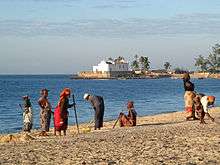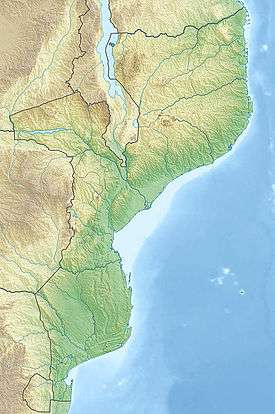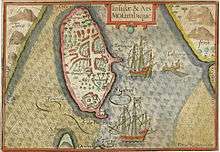Island of Mozambique
 | |
| UNESCO World Heritage Site | |
|---|---|
| Location |
Ilha de Moçambique, Mozambique |
| Coordinates | 15°02′12″S 40°43′58″E / 15.0367°S 40.7328°E |
| Criteria |
Cultural: (iv), (vi) |
| Reference | 599 |
| Inscription | 1991 (15th Session) |
 Location of Island of Mozambique | |


The Island of Mozambique (Portuguese: Ilha de Moçambique) lies off northern Mozambique, between the Mozambique Channel and Mossuril Bay, and is part of Nampula Province. Prior to 1898, it was the capital of colonial Portuguese East Africa. With its rich history and sandy beaches, the Island of Mozambique is a UNESCO World Heritage site and one of Mozambique's fastest growing tourist destinations. It has a permanent population of approximately 14,000 people and is served by nearby Lumbo Airport on the Nampula mainland.
History

The island was a major Arab port and boat building center in the years before Vasco da Gama visited in 1498. The name of the island (Portuguese: Moçambique, pronounced [musɐ̃ˈbiki]) is derived from Ali Musa Mbiki (Musa Al Big), sultan of the island in the times of Vasco da Gama. This name was subsequently taken to the mainland country which is modern-day Mozambique, and the island was renamed Ilha de Moçambique (Island of Mozambique). The Portuguese established a port and naval base in 1507 and built the Chapel of Nossa Senhora de Baluarte in 1522, now considered the oldest European building in the Southern Hemisphere.
During the 16th century, the Fort São Sebastião was built, and the Portuguese settlement (now known as Stone Town) became the capital of Portuguese East Africa. The island also became an important missionary centre. It withstood Dutch attacks in 1607 and 1608 and remained a major post for the Portuguese on their trips to India. It saw the trading of slaves, spices, and gold.
Apart from the ancient fortifications, only half of the town is stone-built. The hospital, a majestic neo-classical building constructed in 1877 by the Portuguese, with a garden decorated with ponds and fountains, was repainted white after the Mozambican Civil War. For many years, it was the biggest hospital south of the Sahara.[2]
With the opening of the Suez Canal, the island's fortunes waned. In 1898, the capital was moved to Lourenço Marques (now Maputo) on the mainland. By the middle of the 20th century, the new harbour of Nacala took most of the remaining business.
Attractions
Other notable buildings on the island include the Palace and Chapel of São Paulo, built in 1610 as a Jesuit College and subsequently used as the Governor's Residence, now a museum; the Museum of Sacred Art, housed in the Church of the Misericórdia run by the House of Mercy, displaying an excellent Makonde crucifix; the Church of Santo António; the Church of the Misericórdia; and the Chapel of Nossa Senhora de Baluarte. The island, now entirely urbanised, is also home to several mosques and a Hindu temple. A 3 km bridge was erected in the 1960s to connect it to the mainland.
The island in itself is not very big, about 3 km long and between 200 and 500 metres wide. Most historical buildings are at the island's northern end. The majority of the residents live in reed houses in Makuti Town at the southern end of the island.
_Chart_of_the_Harbour_of_Mozambique.jpg) Chart of the Harbour in 1810
Chart of the Harbour in 1810 Old Hospital
Old Hospital Church of Santo António
Church of Santo António Makuti Town
Makuti Town
The island is also close to two tourist highlights Chocas Mar, a long beach about 40 km north of Ilha de Moçambique across the Mossuril Bay and Cabaceiras.
References
- ↑ http://whc.unesco.org/en/list/599.
- ↑ Patrick Lagès, The island of Mozambique, UNESCO Courier, May, 1997.
- O.J.O. Ferreira, Ilha de Moçambique byna Hollands: Portuguese inbesitname, Nederlandse veroweringspogings en die opbloei en verval van Mosambiek-eiland. Gordonsbaai & Jeffreysbaai: Adamastor: 2010
- Malyn Newitt, Mozambique Island: The Rise and Decline of an East African Coastal City, 1500–1700. An article from Portuguese Studies.
External links
| Wikimedia Commons has media related to Ilha de Mozambique. |
 Ilha de Mozambique travel guide from Wikivoyage
Ilha de Mozambique travel guide from Wikivoyage- World Heritage Site
- Website managed by the Community Multimedia Center of the Ilha de Mozambique